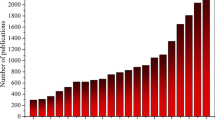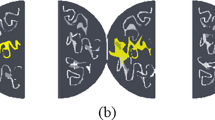Abstract
Fiber metal laminates have many advantages over traditional laminates (e.g., any type of fiber and resin material can be placed anywhere between the metallic layers without risk of failure of the composite fabric sheets). Furthermore, the process requirements to strictly control the temperature and punch force in fiber metal laminates are also less stringent than those in traditional laminates. To further explore the novel method, this study conducts a finite element method-based (FEM-based) strain analysis on multilayer blanks by using the 3A method. Different forming modes such as wrinkling and fracture are discussed by using experimental and numerical studies. Hydroforming is used for multilayer forming. The Barlat 2000 yield criteria and DYNAFORM/LS-DYNA are used for the simulations. Optimal process parameters are determined on the basis of fixed die-binder gap and variable cavity pressure. The results of this study will enhance the knowledge on the mechanics of multilayer structures formed by using the 3A method and expand its commercial applications.
Similar content being viewed by others
References
Zafar R, Lang L, Zhang R. Experimental and numerical evaluation of multilayer sheet forming process parameters for light weight structures using innovative methodology. International Journal of Material Forming, 2014, 1–13
Zhang R, Lang L, Zafar R, et al. Investigation into thinning and spring back of multilayer metal forming using hydro-mechanical deep drawing (HMDD) for lightweight parts. International Journal of Advanced Manufacturing Technology, 2015, 1–10
Zhang S. Developments in hydroforming. Journal of Materials Processing Technology, 1991, 91: 236–244
Koca¨½da A, Sadowska H. Automotive component development by means of hydroforming: A review. Archives of Civil and Mechanical Engineering, 2008, 8(3): 55–72
Sinmazcelik T, Avcu E, Bora M O, et al. A review: Fibre metal laminates, background, bonding types and applied test methods. Materials & Design, 2011, 32: 3671–3685
Botelho E C, Silva R A, Pardini L C, et al. A review on the development and properties of continuous fiber/epoxy/aluminum hybrid composites for aircraft structures. Materials Research, 2006, 9(3): 247–256
Vogelesang L B, Schijve J, Fredell R. Fibre-metal laminates: Damage tolerant aerospace materials. In: Demaid A, de Wit J H W, eds. Case Studies in Manufacturing with Advanced Materials Volume 2. Amsterdam: Elsevier, 1995, 259–260
Tohru T, Takashi M, Norio O, et al. Fatigue crack growth properties of a GLARE3-5/4 fiber/metal laminate. Engineering Fracture Mechanics, 1999, 63: 253–272
Carrillo J G, Cantwell W J. Mechanical properties of a novel fibermetal laminate based on a polypropylene composite. Mechanics of Materials, 2009, 41: 828–838
Takamatsu T, Shimokawa T, Matsumura T, et al. Evaluation of fatigue crack growth behavior of GLARE3 fiber/metal laminates using a compliance method. Engineering Fracture Mechanics, 2003, 70: 2603–2616
Homan J J. Fatigue initiation in fibre metal laminates. International Journal of Fatigue, 2006, 28: 366–374
Long A C. Composite Forming Technologies. Woodhead Publishing Limited and CRC Press LLC, 2007
Park S Y, Choi W J, Choi H S. A comparative study on the properties of GLARE laminates cured by autoclave and autoclave consolidation followed by oven postcuring. International Journal of Advanced Manufacturing Technology, 2010, 49: 605–613
Kumar K V, Mir S, Ahmad A N K. Root cause analysis of heating rate deviations in autoclave curing of CFRP structures. International Journal of Innovative Research and Studies, 2013, 2(5): 369–378
Dmitriev O S, Mischenco S. Optimization of curing cycles for thickwall products of the polymeric composite materials. In: Ataff B, ed. Advances in Composite Materials-Ecodesign and Analysis. InTech, 2011, 141–160
Mohamed R A, Wesley J C. The high-velocity impact response of thermoplastic-matrix fibre-metal laminates. Journal of Strain Analysis for Engineering Design, 2012, 47(7): 432–443
Mosse L, Compston P, Cantwell W, et al. The effect of process temperature on the formability of polypropylene based fibre-metal laminates. Composites Part A: Applied Science and Manufacturing, 2005, 36(8): 1158–1166
Mossea L, Compston P, Wesley J C, et al. Stamp forming of polypropylene based fibre-metal laminates: The effect of process variables on formability. Journal of Materials Processing Technology, 2006, 172: 163–168
Huang S F, Huang K J. Stamp forming of locally heated thermoplastic composites. Composites Part A: Applied Science and Manufacturing, 2002, 33(5): 669–676
Kalyanasundaram S, DharMalingam S, Venkatesan S, et al. Effect of process parameters during forming of self reinforced-PP based fiber metal laminate. Composite Structures, 2013, 97: 332–337
Hou M. Stamp forming of continuous glass fibre reinforced polypropylene. Composites Part A: Applied Science and Manufacturing, 1997, 28(8): 695–702
Author information
Authors and Affiliations
Corresponding author
Rights and permissions
About this article
Cite this article
Zhang, R., Lang, L. & Zafar, R. FEM-based strain analysis study for multilayer sheet forming process. Front. Mech. Eng. 10, 373–379 (2015). https://doi.org/10.1007/s11465-015-0371-9
Received:
Accepted:
Published:
Issue Date:
DOI: https://doi.org/10.1007/s11465-015-0371-9




